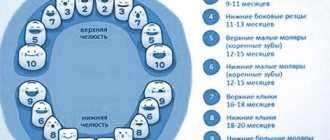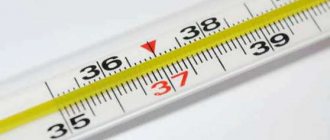Teething is an important event in the life of every child, because he will finally be able to taste solid food. However, the appearance of baby teeth is not always associated with joy and the arrival of the Tooth Fairy. Many children can become irritable and apathetic during the teething period. For some, vomiting, diarrhea, or fever occur when teeth appear.
Whether vomiting is actually caused by teething is controversial. There are no studies confirming the relationship between these natural processes. Most experts agree that teething may cause local pain, but not discomfort in other parts of the body such as rashes or diarrhea.
Other teething symptoms
Some children experience teething without any pain or discomfort. Others may exhibit specific symptoms:
- increased desire to chew;
- salivation;
- cry;
- irritability;
- inability to sleep;
- loss of appetite
- red, tender and swollen gums.
Parents’ concern for the baby’s condition is understandable, because they want to know exactly why the baby’s mood suddenly deteriorated or he began to be capricious.
According to the American Academy of Pediatrics, none of the following symptoms predict the onset of teething:
- cough;
- disturbed sleep;
- decreased appetite;
- vomit;
- diarrhea;
- rash;
- heat.
Vomiting or regurgitation?
In infants, vomiting should be distinguished from regurgitation. With regurgitation, as with vomiting, the contents of the stomach return to the mouth. However, this happens once, immediately after eating. The reason is overfeeding or swallowed air. The air exits back through the esophagus; a slight tension of the abdominal muscles is enough for this. This fundamentally distinguishes regurgitation from vomiting spasms, in which both the abdominal muscles and the diaphragm are involved. When vomiting, the child behaves restlessly, turns red from overexertion, and after an attack he feels weakened.
Why does a baby vomit when teething?
Teething is often wrongly blamed for many symptoms. However, research shows that cough, congestion, vomiting, diarrhea, rashes, fever (over 38°C) and sleep-wake problems are not symptoms of teething. In addition, scientists have found that no single set of symptoms can accurately signal the onset of teething.
The American Academy of Pediatrics explains that from the age of 6 months, a child's immune system weakens, losing maternal antibodies, which increases the risk of exposure to a wide range of diseases, including viruses and bacteria. This is why vomiting may have another cause, but not teething.
Tips for parents
Let's figure out how to avoid possible dangers associated with regurgitation. The main thing that responsible parents need to know is that most often children burp while lying down. This position is dangerous due to aspiration (inhalation) of gastric contents.
Preventing aspiration is simple - just bring the baby upright or turn him on his side or stomach immediately after he burps. Then the baby will be able to push food out of his mouth.
It is worth remembering that it is unacceptable to leave a child with regurgitation syndrome without adult supervision, especially when lying on his back.
How to relieve teething discomfort?
To relieve gum discomfort, you can try massaging or rubbing them with your fingers, or giving your baby a chilled teething ring. If your baby is already chewing, you can offer him raw fruits and vegetables.
Do not give your child painkillers or gum rubs, such as viscous lidocaine or benzocaine. These medications may be harmful if swallowed. The US Food and Drug Administration opposes the use of these drugs due to the risk of overdose.
Overdose symptoms include:
- nervousness;
- confusion;
- vomiting;
- convulsions.
Feeding rules
Frequent regurgitation can be prevented by following a few feeding rules.
- After feeding, it is necessary to hold the baby upright. Even if your baby is tired or wants to sleep, you shouldn’t put him to bed right away. It is very comfortable to hold infants on your shoulder. After waiting for the air to burp, the child can be given any position.
- The same should be done before feeding. The thing is that in an upright position the child can release excess air from the stomach. If this is not done before eating, belching is guaranteed.
- There is a certain position recommended for breastfeeding. One of the main goals of correct positioning of a nursing mother and baby is to prevent regurgitation. The semi-vertical position of the baby with the head raised above the level of the body must be maintained during each feeding.
- Feedings should be frequent, but in small portions. Overfeeding is fraught not only with regurgitation, but also with other digestive problems.
- It is important not to feed your baby when he is crying or laughing, otherwise he will swallow excess air.
- If feeding is carried out using a bottle with a nipple, it is necessary to ensure that the hole in the nipple is not too large, and the position of the bottle is such that the nipple is always filled with mixture and not with air.
- You should refrain from active games in the first half hour after feeding.
Following these simple rules will help reduce the frequency of regurgitation.
When to see a doctor
Teething can usually be managed at home. However, if a child has a high fever and symptoms not related to teeth, this is a reason to consult a doctor.
Some symptoms, such as vomiting, should not be attributed to teething because they may have a more serious underlying cause. Your doctor may want to run some tests to rule out other health problems.
On the Vikids platform you can:
Child behavior
The mechanism of regurgitation is such that components of gastric juice enter the esophagus along with the food eaten. As you know, it has high acidity and irritates the esophageal mucosa. As a result, the child experiences discomfort and can become quite restless. It’s very easy to check whether your baby’s anxiety is related to regurgitation - just lay him on his back. If the problem is regurgitation, then the baby will behave even more restlessly. If not, then the horizontal position will not bring him discomfort.
If regurgitation occurs frequently, it is called regurgitation syndrome. It can lead to complications - chronic irritation of the respiratory tract. As a result of the constant aggressive effect of gastric juice on the mucous membranes of the upper respiratory tract, the latter are susceptible to an inflammatory process. Therefore, it is important to monitor the child’s condition and, if necessary, consult a doctor.
Dental care
The oral cavity needs high-quality hygiene, even if only one incisor has erupted. At first, it is enough to wipe the crowns and gums with a cotton pad or a piece of bandage soaked in clean water (necessarily boiled). You can do this once a day for up to a year.
In one-year-old children, plaque formed from food is removed with a special silicone brush, which is placed on the finger of mom or dad. At 1.5 years old, the baby will be able to clean himself. Two-year-olds pick up the usual children's brushes with soft bristles, suitable for a certain age category.
One of the most important skills is the ability to rinse your mouth. At the age of two, a little person can already learn to do this on his own. Don’t forget about preventive visits to the pediatric dentist. The first visit is indicated at 12-14 months.
Treatment
Treatment is required if respiratory complications occur or if irritation of the esophageal mucosa is suspected. In this case, the specialist will prescribe medications that reduce the acidity of gastric contents. This will not help with regurgitation, but will prevent further trauma to the esophagus. Specific medications are selected individually at an appointment with a pediatrician.
If the cause of regurgitation is an anatomical defect, surgical treatment may be required. Indications for surgery and its scope are specified by the surgeon.
For advice on infant feeding, please contact the specialists at the CELT clinic. Extensive experience, highly qualified clinic doctors and modern equipment are the key to the health and successful development of your children.
Make an appointment through the application or by calling +7 +7 We work every day:
- Monday—Friday: 8.00—20.00
- Saturday: 8.00–18.00
- Sunday is a day off
The nearest metro and MCC stations to the clinic:
- Highway of Enthusiasts or Perovo
- Partisan
- Enthusiast Highway
Driving directions
The order of changing baby teeth in children by age
After the age of 3 years, parents can take a little break from the changes. And then, at about 5 years of age, the baby teeth are replaced by permanent teeth. The process begins with the lower incisors. Then, after about a year, chewing “sixes” are cut, which parents may mistakenly mistake for milk ones. After another year, the upper incisors are replaced.
To go through this journey with your child without problems and pain, visit the dentist regularly. Children may experience pain simply from jaw expansion. Your doctor can easily tell you the cause of the discomfort. The age of 6–7 years shows the prospect of bite formation. Here you can quickly correct problems that arise so that by adolescence your child has a smooth, beautiful smile.
Next, the procedure for replacing baby teeth continues with the upper lateral incisors by the age of 8 years. At the age of 9–10 years, the molar first premolars appear, followed by the second premolars a year later. 12–13 years is the age when canines appear, and at 14 years the last second molars are cut.
The procedure for replacing baby teeth ends with the complete formation of a bite of 24 teeth.
Danger signs
Responsible parents should be aware of dangerous symptoms that require consultation with a doctor:
- The baby is very restless and often turns around and arches his back when burping or feeding. This symptom may indicate chronic irritation of the esophagus.
- Regurgitation is frequent, abundant, observed after each feeding.
- The child is showing signs of dehydration.
- Regurgitation that first appeared after the first half of the year.
- Prolonged regurgitation without improvement (the same frequency and the same volume of regurgitation in a child 1 year and older).
- Regurgitation is accompanied by an increase in temperature.
- The child does not gain weight or even loses it.
- You cannot independently determine whether your baby is spitting up or vomiting.
There are even more dangerous symptoms, when they appear, you need to call an ambulance:
- The child stopped breathing after burping.
- A bluish tint appears on the lips and face.
- After regurgitation, the child lost consciousness.
- Reflux (stomach contents) that is green or brown can be a sign of intestinal obstruction or stomach bleeding.
Aspiration is extremely dangerous in infants who are unable to clear food from their airways on their own. The only thing parents can do is call an ambulance. It is not recommended to try to help your child on your own.
How to help without drugs
Medications are actively used during teething, but how to calm a child when teething using other methods? Massage prescribed by a dentist is highly effective. This way pain is eliminated by slight pressure. Another option is cooling the gums, which causes vasoconstriction (the principle is similar to the effect of ice on bruises and other injuries).
You need to massage painful areas exclusively with clean fingers. Silicone brushes are also suitable, suitable for babies six months of age and older. It is necessary to wash the accessory well and, if possible, sterilize it. Care should be taken to avoid excessive pressure. Some people are of the opinion that physical interference with the natural course of events can subsequently lead to caries and other pathological processes, but this is wrong.
Pharmacies and children's stores sell special teethers made of silicone and other soft materials that do not form jagged edges when chewed. The most effective are models with a non-uniform ribbed surface. Silicone rings with a gel-like substance inside are also used for cooling. You need to place the item in the freezer for a short time, and then give it to the baby.
Chilled complementary foods (mashed potatoes, juice, cottage cheese) will also relieve pain. A one-year-old can be offered a cool banana or apple.





